The marking of LG TVs displays basic data about the device, for example, its diagonal size, year of manufacture and series. In addition, it indicates which tuners are built-in, design features, as well as for which country or region it was manufactured. this device. However, in order to understand all this, you need to know how to read the encoded information.
LG is no exception and, like everyone else, uses a certain system data encodings. All TV that was released since 2011 had a certain, one might say, standard system encodings. Starting from 2016, new models are marked according to a different scheme. Today we will look at the features of deciphering the markings of LG TVs from 2011-2015.
Diagonal
At the very beginning of the marking there is an indication that this is a TV produced by LG. After this comes a two-digit number, which means the diagonal size of the screen, indicated in inches (1 inch - 2.54 centimeters).
The most popular models are 32, 40 and 50 inches. It all depends on where you will place the TV in the future and from what distance you are going to watch it. Also, keep in mind that the larger the screen size, the more you will have to pay.
Widget from SocialMartScreen technology
The next letter indicated after the diagonal is responsible for what technology was used in the manufacture of the screen. It is worth considering that there are five types of technologies that LG uses in the manufacture of its products:
- C – LCD TV with a liquid crystal matrix and fluorescent backlight. Most often these are devices that were manufactured in 2011-2012. On this moment they are discontinued;
- E – devices with an OLED screen;
- L – liquid crystal displays with LED backlighting;
- P – plasma panels. No longer produced;
- U is a screen with a matrix based on liquid crystals with LED backlighting and 4K resolution.
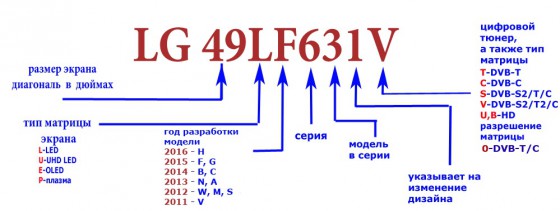
Year
The next letter indicates the year the TV was manufactured. At the same time, to indicate the features, specifications and the presence of a particular function, one or more letters were used. So, let's take a closer look at what TVs were produced in a given year.
2015:
- EF – OLED devices with 4K resolution and flat screen;
- EG – OLED TV, with a curved screen with Ultra HD resolution and a four-color matrix;
- LF – LCD TV with Full HD resolution;
- UF – flat LCD TV with Ultra HD resolution.
year 2014:
- EC - TVs with OLED screens;
- LB – Full HD LCD screens;
- LY – LCD TV intended for commercial purposes. Installed in hotels, offices and bars;
- UB – liquid crystal devices with Ultra HD screens;
- UC – LCD TV, characterized by a curved screen.
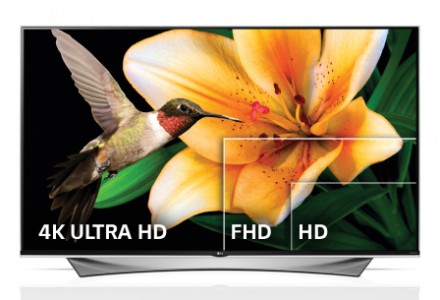
year 2013:
- LN – liquid crystal TV;
- L.A. LCD screen, supporting 3D function.
2011-2012:
- LM and LW are 2012 devices that support 3D;
- PA, PM, PS – plasma TV model range 2012;
- LV – TV 2011.
Series
After the letters in the markings and designations of LG TVs there are numbers. The first digit indicated after them indicates the series number. The higher it is, the more features and functions this TV has. It all starts with episode 4 and ends with episode 9. Episode nine is the best.
The series differ from each other not only in the number and presence of such functions as the Smart TV version, support for video in 3D format, frame refresh rate and others, but also in the components that were used to create the TV (the number and availability of certain connectors , processor features, etc.).

Every year, the features of a particular series undergo certain changes, so in order not to confuse anything, you should look at the specification separately for each year. In general, the following distinction can be made between each series:
- 4 - small devices intended for installation in the kitchen, etc.;
- 5 – TVs that do not support 3D format and have a display no larger than 50 inches;
- 6 – the screens of these devices can reach 60 inches. Watching movies in 3D format is supported. The most popular series;
- 7 - the same as the 6 series TVs, but, in addition, they have indexing of dynamic scenes, as well as higher performance;
- 8 – the same as the 7 series, but the kit also includes various accessories, such as web cameras, etc.;
- 9 - a series of televisions, no different from the 8th, but with the maximum large screens, the size of which starts from 80 inches and can go up to 100.

Model and design
The following two numbers are responsible for this. The first one means the model in this series. The higher this number, the better characteristics devices.
The second number indicates design features. It can indicate color, lighting features, rounded shapes, and so on.
Tuners
At the end of the marking, a letter is indicated that tells which tuners were built into the TB from LG and what types of signals they can work with. There can be four letters in total:
- C – tuner working with DVB-T and DVB-C formats;
- S – a tuner that can receive and decrypt the same formats as the previous one, plus satellite signals in the DVB-S/S2 format;
- T – tuner that works with both formats digital television, as well as with the DVB-C standard;
- V is a tuner that supports all available formats of digital, cable and satellite television.

Product code
In addition to standard markings and designations, LG TVs also have a product code, which encrypts Additional Information. This code consists exclusively of letters. So, the first letter will indicate which part of the world the TV is intended for:
- A – Australia;
- N – USA and Canada;
- S – countries of South America;
- T – African countries and the East;
- U – Asian countries;
- Z – European countries.
The second letter relates to design, so it can be ignored. Next comes a letter indicating in which country the board installed in this TV was manufactured. There are three options in total:
- B – Russia;
- A – Korea;
- C – Czech Republic.

The next two letters indicate which country it is intended for. So, if the TV was made for Russia, then you can read RU, for Ukraine - UA, Belarus - BY, Poland - PL, and so on.
After this comes a letter that corresponds to one or another matrix that was used. A total of 15 matrices can be used, and accordingly the range of letters will be the same.
Next will be the letter W or L, indicating the type of backlight, and at the end there will be two letters that also indicate the country, but this time the country of assembly. Since all LG TVs are assembled in only four countries, this could be:
- LH – Korea;
- JU – Russia;
- JG – Poland;
- LA - Czech Republic.

Serial number
In addition to the markings and product code, LG TVs have a specific serial number, which also contains encrypted information. This number consists of letters and numbers and is deciphered as follows:
- The first digit indicates the year of manufacture. Accordingly, if the number starts with the number 4, it means the TV was manufactured in 2014;
- The next two-digit number is responsible for the month, that is, 02 is February;
- The letters indicated after the first three digits allow you to find out the country in which this TV was manufactured.

The country of origin may be indicated as follows:
- AK – Kazakhstan;
- L – Czech Republic;
- MA or WR – Poland;
- PT – Korea;
- RA – Russia.
After the country is indicated, there are also letters and numbers, but you should not pay attention to them, since they will not carry any fundamental meaning for the user. important information. They may only be of interest to specialists.
Why should I even be interested in this?
It’s important and even very important! The TV marking (plate) can warn you against making the wrong purchase.
So, it’s time to talk about purposefully choosing a TV and, oddly enough, the LG TV label will help us with this.
You can even object to me! After all, the seller must explain everything, why should I delve into the set of letters and numbers on the plate?
Of course, you don’t have to go into it, but I doubt that the seller will tell you from the first words about the bad things about a particular TV.
But anything can be hidden!
For example... is there a built-in tuner for satellite reception, year of manufacture, country of manufacturer (who actually did the assembly) and much more.
I already wrote about the moments of my painful choice of TV in the article:
That’s why I’ll talk about the LG TV line.
I’ll add that 4K is still tomorrow for many, and FUL HD is today, but I note that on a 4K TV even FUL HD looks much better, there are more pixels.
But I’m talking about myself again, I’m still in a good sense of the word “dragging” on the excellent 4K picture.
So, screen size
The first two digits in the designation of LG TVs indicate the screen diagonal size in inches. One inch is equal to 2.54 centimeters.
Increasing the diagonal size by a few inches can greatly affect the price, so you need to pre-size your TV based on the distance from which you will be watching it.
The most popular among buyers are TVs with diagonal sizes from 32 to 50 inches. I even recommended 55, don’t regret it.
About display manufacturing technology
The screen type can be recognized by the letter immediately after the first two numbers indicating the screen size.
E – OLED screen;
L – liquid crystal matrix (LCD) with LED backlighting;
U – liquid crystal matrix with LED backlighting and Ultra HD resolution;
C – liquid crystal matrix (LCD) with backlight from fluorescent lamp(no longer produced);
P – plasma panel.
Year of manufacture
The year of manufacture of the TV is indicated by the next letter after the letter of the screen type. Each year, two or more letters were used in the labeling, indicating the presence of certain functions in a particular year.
2015
o LF - TVs with Full HD resolution;
o UF - TVs with 4K resolution, flat screen;
o EG - OLED 4K TVs with curved screen.
year 2014
o UB — TVs with 4K UHD resolution screens;
o LB - TVs with Full HD screens;
o UC-TVs with curved C-curved screens;
o EC TVs with OLED screens;
o LY - commercial TVs (for offices, bars, hotels).
2013 and earlier:
o 2013 – LN, LA (LA with 3D function, LN without 3D);
o 2012 – LW, LM, PA, PM, PS (LW and LM with 3D);
o 2011 – LV.
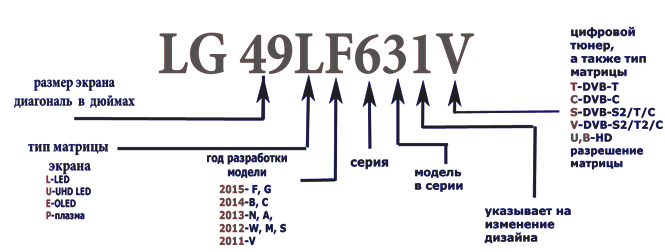 LG TV series
LG TV series
The following numbers in the marking indicate the series and model in the series. The larger the number on each position, the more functions it has this model and so better technology applied.
The series can range from 4 to 9. The most advanced is the 9th series.
The series and set of functions differ (3D, Smart TV version, frame rate, etc.), the components used (processor model, set of connectors, etc.).
Every year distinctive features each series changes, to know exactly how the series differ, you need to familiarize yourself with the specifications for a specific year on the LG website or on specialized resources.
From year to year certain components and functionality become cheaper and move to the lower series.
So if some models are expensive for you this year, then in a year or two you will be able to buy a TV with the same capabilities for less.
The following numbers after the series number are the model in this series and the modification of this model. The higher these numbers, the better the TV's performance.
Tuner designation
The last letter in the LG TV marking indicates the type of tuner for signal reception.
T - tuner formats DVB-T/T2, DVB-C;
S - tuner formats DVB-T, DVB-C, DVB-S/S2;
V - tuner formats DVB-T/T2, DVB-C, DVB-S/S2;
C - DVB-T, DVB-C tuner formats.
For built-in satellite TV reception, we need DVB-S/S2 to be present in the designation.
Decoding the product code
The TV label usually contains additional information, encrypted in letters and called the “product code”.
1) The first letter indicates the continent of destination:
Z – Europe;
U – Asia;
T - East and Africa;
N - North America;
A – Australia;
S - South America.
2) The second letter refers to design.
3) The third letter indicates the country of manufacture of the TV board:
A – Korea;
In Russia;
C – Czech Republic.
AE – United Arab Emirates;
AM – Armenia;
AT – Austria;
AZ – Azerbaijan;
BG – Bulgaria;
BY – Belarus;
CZ – Czech Republic;
EE – Estonia;
GE – Georgia;
HU – Hungary;
KR – South Korea;
KZ – Kazakhstan;
PL – Poland;
RU – Russia;
UA – Ukraine.
5) Next comes the letter designating the matrix used in the LG TV:
Z - LG IPS, 120 Hz matrix;
R - LG Display Co.Ltd. TN;
W - LG Display Co.Ltd. S-IPS;
Y - LG Display Co.Ltd. S-IPS;
U - LG Display Co.Ltd. IPS WUN SAB1/SAB2;
P - LG Display Co.Ltd. IPS WXN SBA1/SBA2;
Q - LG Display Co.Ltd. IPS WXN SAA1/SAA2;
V - LG Display Co.Ltd. IPS WUD SBA1/SBA2;
G - CHI MEI OPTOELECTRONICS CORP. TN;
H - CHI MEI OPTOELECTRONICS CORP. S-MVA;
J - CHI MEI OPTOELECTRONICS CORP. S-MVA;
D - AU OPTRONICS CORP. TN;
T - AU OPTRONICS CORP. AMVA;
M - SHARP CORPORATION VA;
S - SHARP CORPORATION VA.
6) The next letter indicates the type of backlight (L or W).
7) The last letters indicate the country where the TV was assembled:
JG – Poland;
JU – Russia;
LH – Korea;
LA – Czech Republic.
The plate from my TV has nothing to do with the description of the markings.
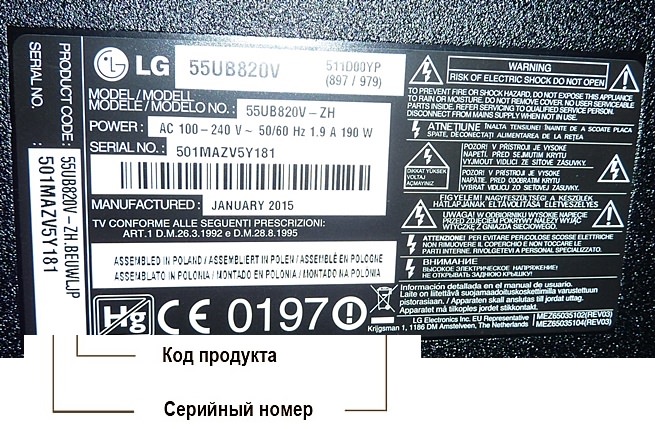 Example of product code decoding:
Example of product code decoding:
Randomly taken TV model!
The label says: Product code: 42LA620V - ZA.BRUYLJU. Here “42LA620V” is the name of the model and how to decipher it is written above. But let’s try to decipher the designation “ZA.BRUYLJU”.
Z - TV for Europe;
A - refers to design;
B — the board was assembled in Russia;
RU - TV made for Russia;
Y - matrices in the TV receiver LG Display Co.Ltd. S-IPS;
L - indicates backlight;
JU - country of assembly Russia.
LG TV serial number
IN serial number encrypted:
1) The first digit indicates the year of manufacture.
2) The next two digits indicate the month of issue.
3) The following two letters indicate the country of manufacture:
PT – Korea;
RA – Russia;
AK – Kazakhstan;
L – Czech Republic;
WR/MA – Poland.
If you have any difficulties working with your LG TV, the best solution would be to contact technical support. LG technical support service is a staff of specialists who should solve almost any problem that arises.
To write to LG support, go to:
https://www.lg.com/ru/support/message-customer-support (Russia);
https://www.lg.com/ua/support/message-customer-support (Ukraine). and fill out the contact form there.
Try to include all the important information and details that can help solve your problem. Next, you just have to wait for the support service to respond.
If you have any questions, you can also contact Customer Support by phone ( toll free line):
8-800-200-76-76 (Russia)
8-820-0071-1111 (Belarus)
Beware of updating to firmware 04.45.04, your TV may freeze, so much so that without a technician, you may even have to send it to a service center.
Good luck, Friends!
When buying serious equipment, such as a TV, you always want to know more about it than what is written on the store price tag. Today we will tell you about one effective way to get a little more of this information - you just need to decipher the labeling of LG TVs. Let's look at sample examples and the meanings of all existing notations.
LG TV designations
The TV marking is usually indicated on the price tag, so you can find and decipher it even without the help of a sales assistant. For LG equipment it looks like this:
LG 00 A B 2 3 4 C, where:
- 00 - the first two digits indicate the size of the TV display (in inches);
- A - letter codes of the type of screen matrix;
- B - letter code of the year when this model was developed;
- 2 - series to which the device belongs;
- 3 - serial number of the model in the series;
- 4 - a number indicating any changes in the design;
- C - letter code of the matrix type, its resolution, digital tuner.
Please note that the markings of LG OLED TVs are slightly different from those presented:
OLED 00 A 1 B, where:
- OLED - TV display type;
- 00 - screen diagonal in inches;
- A - number of a model with excellent design;
- 1 - the year when this model was presented by the developers;
- B - device tuner type.
Now you can move on to more detailed analysis each item
Display size
Everything is simple here. LG 42... TV is a device with a screen diagonal of 42 inches. For reference: 1 inch is 2.54 cm. The dimensions of the display have a direct impact on the price, so even a difference of a few inches can have a significant impact on the cost.

The fastest-selling models are with a diagonal of 32-50 inches. More and more buyers are opting for 55-inch screens. Therefore, the TV that we indicated in the example is an average model in terms of these characteristics.
TV screen type
The second part of the model markings says the following:
- P - in front of you is a plasma panel.
- C - LCD (liquid crystal television) with fluorescent backlight.
- L - LCD TV with LED backlight (based on LED lamps).
- U - LCD screen with LED backlight and Ultra HD resolution.
- E, EC - OLED display (until 2016, then such models began to be labeled OLED ..., which we discussed in the previous section).
- S - innovation of 2017, Super UHD TV with a Nano Cell matrix (a super matrix with light-emitting particles whose size does not exceed 1 nanometer).
- (LG) LF - TVs with high quality Full resolution HD.
- UF is a flat screen TV with 4K resolution.
- EF is an OLED TV with a flat display whose resolution is 4K.
- EG is an OLED TV, but with a concave screen, whose resolution is also at least 4K, and the matrix is four-color.
- UB is a device with a 4K screen resolution.
- UC is a TV with a concave C-curved display.
- LB - equipment has Full HD screen quality.
- LY is a special designation for commercial large TVs that are used in bars, hotels, supermarkets, etc.
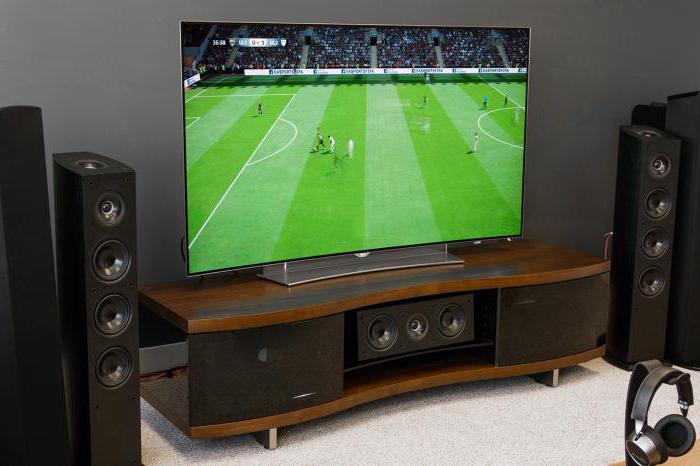
LCD, plasma, OLED: advantages and disadvantages
Thus, today the company provides three main types of TVs:
- LCD (liquid crystal)- such a screen consists of an LCD matrix (liquid crystals located between polymers), light sources, wires, and a housing that imparts rigidity. Each “liquid crystal” is two layers of polarizing filters, between which are electrodes, and between them, in turn, is a layer of molecules.
- Plasma (SED)- so-called gas-discharge monitors. Their work is based on the glow of a phosphor under the influence of UV rays. The latter arise during the passage of an electrical discharge.
- OLED- this type of screen is made of organic compounds that are capable of emitting light when an electric current passes through them.

Let's look at the main advantages and disadvantages of the presented LG TV models in the table.
| Variety | pros | Minuses |
| Liquid crystal displays | Low weight and size of the device. Unlike electron beam devices, there is no flickering, image focusing defects, or interference with the clarity and geometry of the transmitted image. Many models are characterized by obviously low energy consumption - it depends entirely on the power of the lamps or LED backlights. | A clear image is only possible with one resolution. Low image contrast, as well as black depth. Sometimes there is a problem of uneven brightness of the image. Practically not protected from mechanical damage. The "dead pixel" problem often occurs. Replacing fragile matrices is very expensive. Small range of permissible operating temperatures. |
| Plasma TVs | Color depth. Uniformity of luminescence of black and white colors. Long service life (according to some manufacturers, up to 30 years). | Increased power consumption (compared to LCD monitors). Large-sized pixels imply the development of large-sized screens. Screen burn-in may occur in areas where a still image is displayed for a long time. |
| OLED displays | Light weight and dimensions. Low power consumption while maintaining high image brightness. Possibility of developing flexible displays. The ability to create TVs with giant screens. No need for backlighting. Wide viewing angle - the image is clearly visible from any angle. No inertia, instant response. High picture contrast. The screen can fully operate in a wide range: -40 ... +70 o C. | Short service life of diodes. Red and green compounds fade much more slowly than blue, which can significantly distort the color rendition of the image. The impossibility of creating durable 24-bit displays. High price combined with some imperfect technology |
Having analyzed the features of the presented types of screens, we move on to deciphering the markings.
Year of development
The letter code corresponding in the marking of LG TVs for the year of development of a particular model may be as follows:
- J - 2017.
- H - 2016.
- G, F - 2015.
- C, B - 2014.
- A, N - 2013.
- M, S, W - 2012.
- V - 2011.

LG TV series
Let's look at the LG TV series and their distinctive characteristics in the following table.
Let's move on to the penultimate marking point.
Model number
The following two symbols in the LG TV markings mean the following:
- The first digit is the number of this model in the series from the subheading above.
- The second number highlights any design features of the TV you have chosen: color, design solution, shape of its stand, etc.
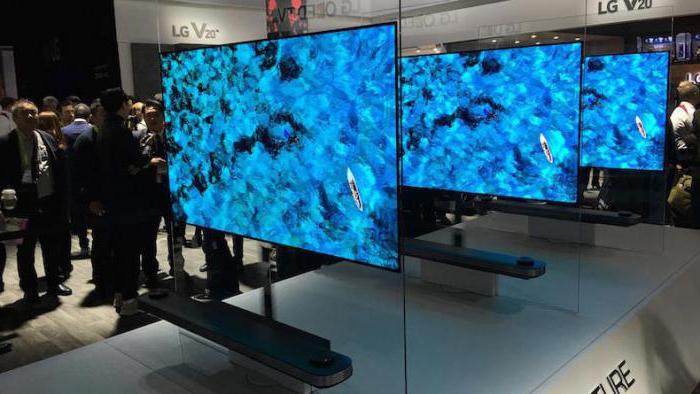
HD support and tuner
The last letter code will tell you about the capabilities of the matrix or tuner to support a certain resolution. Let's present this information in a table.
The most “successful” code is, of course, V. Such televisions support all formats of TV broadcast in Russia and the CIS countries. In addition, this letter designates Full HD screens.
Tuner types
Let's tell you more about the voiced formats:
- DVB-C- a pan-European digital TV standard used by cable operators.
- DVB-S, DVB-S2- the TV’s support for these digital TV formats means that to watch satellite channels you will only need a satellite dish and special card from the provider. A special set-top box (receiver) is not needed.
- DVB-T, DVB-T2- the first format of terrestrial digital TV (caught by a conventional remote antenna) is typical for the countries of the European Union, and the second - for Russia and the CIS countries. Although the T2 is an improved version of the T, they are not interchangeable.

That's all we wanted to tell you about the labeling of LG TVs. We hope that the information presented will help you make the right choice when purchasing, or you will learn a little more about the equipment you already have. It goes without saying that the information indicated in the labeling should not contradict the characteristics of the product in its documents, warranty card, instructions - this state of affairs may be grounds for doubting the authenticity of the TV.
The TV marking bears technical information about this model. Usually the most important information for the buyer is encrypted, for example, year of manufacture, screen size, model series, type of digital tuner, etc. You will see the marking on the price tag in the store, in the model name in the online store, in the label on the TV itself.
Decoding OLED TV markings
In 2016, LG changed the labeling of its OLED TVs. Previously, they were labeled like other models, but now everything is different. And so, for OLED models:
- The first two digits are the screen diagonal in inches
- The letter defining the class of the model (G – flagship, E – high class, B – basic level, C – high class with curved screen), this was the case in 2016. In 2017, all models are OLED with a flat screen, and the letters are now: W, G, E, C, B.
- The number is the year of manufacture of the model, for example in 2017 this number is “7”, and for 2016 it is “6”
- The letter indicates the destination region
- V – Europe
- J – Eastern Europe
- D – Austria, Germany, Switzerland
- R – America, China, Japan
- K – Korea
An example of LG 2016 OLED TV markings:
- LG – manufacturer LG
- 65 – screen diagonal size in inches
- G – the flagship among OLED TVs
- 6 – 2016 model
- V – Europe
LG 65G6V
LG LED TV designation
The labeling of LG LED TVs in 2017 remains the same as in previous years. This marking also applies to OLED models 2015 and older.
Screen size
The first two digits indicate the screen size in inches. To convert to centimeters, you need to multiply this number by 2.54. And you can look.
Display technology
- E – OLED displays (designation used until 2015)
- S – model belongs to the “Super UHD” class, liquid crystal display with 4K resolution and Nano Cell technology
- U – liquid crystal display backlit by LEDs (LED TVs) with 4K resolution
- L – liquid crystal display backlit by LEDs (LED TVs) with Full HD resolution
Year of manufacture
The year of manufacture of the device is indicated by a letter. There may be several such letters for each year; they mean different parameters.
2017 – letter J for LED models, SJ/UJ = 2017, UH = 2016, UF = 2015, UB = 2014.
2016 – letter H for LED models.
- LH – LED TV with Full HD resolution
- UH – LED TV with 4K UHD resolution
All LG OLED TVs have 4K UHD screen resolution
2015 – F for flat screen, G for curved screen.
- EG – OLED TV with curved screen
- UF – LED TV with 4K resolution and flat screen
- LF – LED TV with Full HD resolution and flat screen
2014 - the letter B means flat screen, C - curved screen
- UB – 4K UHD resolution, flat screen
- LB – Full HD resolution, flat screen
- UC – 4K UHD resolution, curved screen
- EC – OLED TV with curved screen and 4K UHD resolution
TV series
After the year of manufacture there are several numbers and the first of them indicate the model series and sub-series.
The series are numbered from 4 to 9. In some years the number of series may be less, but the rule that the highest series is more technically advanced always remains.
The next number indicates a sub-series and indicates minor differences in parameters within the same series. The higher the subseries number, the better the characteristics of the device.
The last number indicates design features.
To receive a television signal, you need a tuner, and the last letter indicates the type of tuner in this TV model.
- T - DVB-T/T2, DVB-C;
- S - DVB-T, DVB-C, DVB-S/S2;
- V - DVB-T/T2, DVB-C, DVB-S/S2;
- C - DVB-T, DVB-C.
What signals does each type of tuner receive:
DVB-S/S2 - satellite digital channels can be received
DVB-T/T2 - reception of terrestrial digital television channels (digital television)
DVB-C - digital cable television
Today, tuners under the letter V are common on LG TVs, which allow you to receive everything digital channels DVB-T/T2, DVB-C, DVB-S/S2.
An example of decoding the name of an LED TV
Let's take the 2016 model LG 49UH600V as an example.

- LG - manufacturer LG
- 49 - screen diagonal 49 inches
- U - this is the designation for LED TVs with 4K Ultra HD resolution
- H - year of manufacture 2016
- Episode 6
- 0 - sub-series within series 6
- 0 - design features
- V - tuner DVB-T2, DVB-C, DVB-S2
